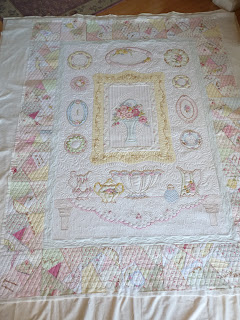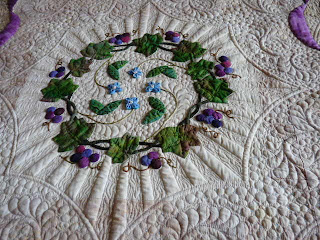There is one best thread for the job. NOT TRUE.
My machine only runs with "such-n-such" thread. PROBABLY NOT TRUE. Or, hopefully not true. You probably are not comfortable adjusting the tension as you change threads if this is your opinion.
I have seen so much verbage to this effect lately on the blogs and facebook. It forced the interest in my looking back over many of the quilts I have done, both for myself as well as for clients to see what threads I used most freuently, and why each was chosen. That is probably the more important point. I don't choose threads for a quilt because I like stitching with a particular kind of thread. I choose it because it is what the particular quilt would look best with.
There is a nearly endless selection of threads that each quilt can be quilted with. I will admit right off to not liking to quilt with cotton thread, and more than a year ago I just sold off all my cottons. It is not that my machine can't run with it; I just don't care for the additional lint or the more frequent thread breaks. So, with that said, just within the realm of polyester thread, there are a whole host of options. There is also metallics (also a poly thread) and silk. So, lets look at some of the quilts and talk about why I chose what I chose.
This is Sea Glass. You have all seen it, I know. It is batiks and hand-dyes, and the background is pieced in a watercolor style. Right up front I'll admit that this quilt may have looked great quilted in the shinier threads (Glide, Rainbows, Magnifico - as examples), at the time it was made, I didn't use of know of Glide and Magnifico wasn't around. I chose, instead, a very fine 100wt Invisifil. It is so thin that it really only leaves the texture behind, which is exactly how I wanted the quilting to be. All of the colors and textures of the fabric are visible, and not overshadowed by the thread. In retrospect, though the sheen of Glide would have been pretty, I do think that the 40wt thickness of this thread would have overpowered the delicate texture I was aiming for. JMHO.

I also used a blue Rainbows thread on the waves and the inner blue border as well. It's a 40wt variegated thread, similar to Glide, but for me it is occasionally prone to unpredictable shredding so I use it in small areas and rarely on entire quilts. It works well here. Glide would have too, but it's not variegated.
A client made this quilt. It is stitched all in 50wt So Fine thread. Her fabrics all have a lot of print. This quilt was again stitched before I used the shinier threads as often as I do now, but I wanted the fabric patterns not to fight with the quilting patterns. So Fine is a good thread for that objective. Additionally, I have many (not hundreds, but an adequate 60-80) color selection of this thread so finding a good shade was easy. So Fine is heavy enough that it shows, but still fine enough that the pebbling can be stitched and not appear grossly thready.
This is one of my show quilts. Again, I like to use batiks. A multitude of different threads work well with the batiks. I, however, chose to stitch the feathers in a soft lavender So Fine thread, and the back fills in Invisifil. The So Fine has enough thickness to subtly show the color nicely.
The darker colored areas of quilts can take heavier threads more easily than the lighter fabrics. The purple pieced sections have a nice variegated purple Rainbows thread. It is 40wt and shows just enough. Fast forward 2 years, a Glide thread would have been good on some areas of this quilt, but I still probably wouldn't use it everywhere. Just too much shiny.
This is a still-unfinished whole-cloth quilt on silk Radiance. Today, I would quilt it using silk 100, but 20 months ago I chose the Invisifil, another very fine thread. It stitched beautifully. The actual quilting thread is barely noticeable, just as it would be with silk. It leaves behind beautiful texture. This is really not the style quilt you'd want to see a 40wt Glide all over. It would be too thready for sure. The very fine thread allows the fabric and texture to steal the show.
Zen Garden is one of my favorite quilts to date that I have made. It has significant texture just in the larger-scale prints that were used in the piecing. Again, I didn't want the texture from the quilting to interfere with the fabric prints and piecing. This quilt is stitched with both Invisifil and silk 100 (tan). It has areas with very dense quilting that this super fine thread can't even begin to alter the fabric's color. It is just quilting texture. The print and the piecing/applique were busy enough; I didn't want to see the thread, only it's texture.

Postcards from Venice was my first intentional show quilt. Admittedly, two years I was not adventurous in my thread choices, nor did I have much selection beyond So Fine. It is completely appropriate for the quilt though. I used a metallic thread, which I pretty much loathe stitching with on areas where the fabric has a metallic flecking, but everywhere else, I wanted a flat look without sheen. This is a quilt of an inlaid mosaic floor. Shiny didn't seem right. Was this the right choice? I guess.
In my uncertainty, I used a metallic bobbin thread on the back of the quilt though to help hide where I had backtracked over some seams more than I may have wanted. This got good reviews from all the judges - not that it is required, but that it was an interesting and unexpected element. It is nice to have surprises.
This is Sue Garman's Stars for a New Day, expect it is in miniature, only about 40" square! Glide would be spectacular on a full size version of this quilt, but the miniature required a finer thread. I used both So Fine and Bottomline.
Patriots and Petticoats...a very much NOT miniature (nearly 100") quilt, in a reproduction style and fabrics. I think that there needs to be some consciousness to preserving the era of the quilt. I like the reproduction and CW quilts to be done using patterns that the original (albeit, then hand quilted) may have been done in. Additionally, I like the thread to look like a hand quilting thread. Since I don't like/use cotton, I choose a polyester thread that resembles cotton - Superior's Omni. This thread stitches beautifully for a 40wt thread. It's flat, non-shiny and tensions nicely. I don't do super dense fillers with it, but when the style desired is similar to this, Omni is great.

This is a recently done client quilt, or a very small shot of the entire quilt. The majority of the quilt is white Fairy Frost, with color-enhanced hand-embroidery. It is lovely, delicate, shimmery and oh-so feminine. This quilt, more so than many others I have quilted recently was screaming for Glide thread. The shine on top of what is a mostly solid, blank canvas is perfect. If you are confused, I will post this quilt in a post later this week. Unfortunately, it is hard to convey "sheen" in a photograph.

This is a mere section of a wall-hanging I did this winter. Much of the thread blends, but the large, sweeping curves and cross-hatching and feathers is stitched with a silver metallic thread. As I mentioned early on in this discussion, I am not a huge fan of metallics. They shred and can just be tempermental to deal with. On top of that, they aren't super soft to the touch so I wouldn't want it on a quilt that I handled or slept on. But this metallic by Wonderfil is quite soft, and stitches pretty well. And in moderation, it gives a great effect. As an alternative to dealing with the headaches of metallics, the Glide thread in the same color can have a similar effect. A little goes a long way with metallics.

I do love Glide, as many of you all do too. I have used a gold Glide on a couple of recent show quilts, including the one below. This quilt is made with the Stonehenge fabrics, and several have gold flecking. I think the shiny gold thread looks nice on them, showing up just the right amount. I particularly like the use of a slightly more showy threads in this case because the fabrics read as mostly solid or mottled. On true prints, however, Glide is not always my preference.

I guess it's about time to wrap up this thread discussion. This is a recent quilt of mine, Big Bertha. I will be at MQX in 2 weeks. I stitched this with silk 100 in 4 different colors, each matching the fabric. It's monochromatic so that the texture shows, not the thread color. I chose the finer silk thread over a So Fine or Glide because I stitched several areas quite densely, I don't care for the look of thread build up. Silk thread is pricey -- probably $40 on this quilt on the top only (not counting the bobbins), but it runs so smoothly, not having the shredding that poly can have.

What is the whole point of this? Are you wondering?...My point is that there are a plethora of threads available for us to quilt with -- way more than I have even used or probably even know about. I have stitched with many, and though I may have ones I like better than others, I know that one thread definitely does not fit all quilts. I can't reasonably use silk on all my client quilts just because I love how it runs. It is expensive. But I do make exceptions on my own work. Different quilts call for different textures, thicknesses and sheens. Your choices may not be the same as mine, but perhaps some of my rationales explained here will give you some guidance when your next quilt asks "what thread to I use?" Don't be afraid to experiment or to learn to use different threads. It is OK to mix different threads on a single quilt. Variety is the spice of life :-)





































































